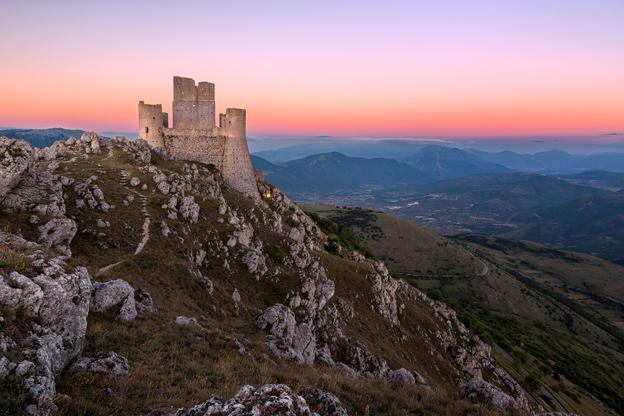Abruzzo's Rocca Calascio: The Highest Fortress in the Apennines
ITA:

A large number of castles dot the region of Abruzzo, scattered through towns, hilltops and mountain passes.
One of the most famous and impressive is the 13th-century Rocca Calascio, which, rising majestically at an elevation of 1,460 meters (4,790 ft), is the highest fortress in the Apennines.
Construction of Rocca Calascio began in the 10th century when a watchtower was built on a mountain overlooking the southern slope of the Gran Sasso, the Valle del Tirino and the Navelli Plain, in a strategic position that constituted the highest point within a lookout system set up to control and defend the territory.
In the 13th century, a walled courtyard with four cylindrical towers at the corners around a taller inner tower were added.
The defensive system had three elements: the fortress, its walls and the village below.
Rocca Calascio was never intended as a noble residence, but was built exclusively for military purposes and to accommodate troops, as evident from its architecture and design. Built of stone and masonry, its lower half features larger stones than its upper half, probably to make the base unassailable. The fortress, however, was never used in a battle. It was instead badly damaged by a powerful earthquake in 1481.
Owners of the Rocca included the Medici of Tuscany.
A church, Santa Maria della Pietà, was built near the fortress, slightly below, in the 17th century.
Because of its spectacular position and breathtaking views, Rocca Calascio has been used to film scenes for a number of movies, including Ladyhawke, The Name of the Rose and The American.
Tra i numerosi castelli che costellano l’Abruzzo, sparsi tra città, colline e passi di montagna, uno dei più famosi e spettacolari risale al 13° secolo: si tratta di Rocca Calascio, che si erge maestosa ad un'altitudine di 1.460 metri, la più alta fortezza dell’Appennino.
La costruzione di Rocca Calascio cominciò nel 10° secolo, quando una torre di avvistamento fu costruita su una montagna che domina il versante meridionale del Gran Sasso, la Valle del Tirino e la piana di Navelli, in una posizione strategica che costituiva il punto più alto all'interno di un sistema di avvistamento creato per controllare e difendere il territorio.
Nel 13° secolo, furono aggiunti un cortile circondato da mura e con quattro torri cilindriche agli angoli intorno ad una torre interna più alta.
Il sistema difensivo aveva tre elementi: la fortezza, le mura e il villaggio sottostante.
Rocca Calascio non fu realizzata come residenza nobile, ma fu costruita esclusivamente per scopi militari e per ospitare le truppe, come evidente dalla sua architettura. Costruita in pietra e muratura, presenta una metà inferiore con pietre più grandi rispetto alla metà superiore, probabilmente per rendere la base inattaccabile. La fortezza in ogni caso non fu mai utilizzata in una battaglia. Fu invece gravemente danneggiata da un potente terremoto nel 1481.
Tra i proprietari della Rocca vi furono i Medici.
Nel 17° secolo, vicino ma in posizione più bassa rispetto alla Rocca, fu costruita una chiesa, Santa Maria della Pietà.
A causa della sua posizione spettacolare e dei panorami mozzafiato, Rocca Calascio è stata utilizzata come set per le scene di vari film, tra cui Ladyhawke, Il nome della rosa e The American.











